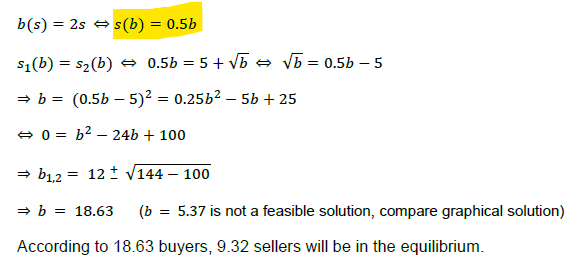Aufgabe:
Consider a two-sided market in which the number of sellers (s) depends on the number of buyers (b) and vice versa. Specifically, these numbers are b(s)=2s and s(b)=5+√b.
b) How many sellers and buyers will be in the market in the equilibrium?
Lösung:

Text erkannt:
\( b(s)=2 s \Leftrightarrow s(b)=0.5 b \)
\( \begin{array}{l} s_{1}(b)=s_{2}(b) \Leftrightarrow 0.5 b=5+\sqrt{b} \Leftrightarrow \sqrt{b}=0.5 b-5 \\ \Rightarrow b=(0.5 b-5)^{2}=0.25 b^{2}-5 b+25 \\ \Leftrightarrow 0=b^{2}-24 b+100 \\ \Rightarrow b_{1,2}=12 \pm \sqrt{144-100} \end{array} \)
\( \Rightarrow b=18.63 \quad(b=5.37 \) is not a feasible solution, compare graphical solution \( ) \)
According to 18.63 buyers, 9.32 sellers will be in the equilibrium.
Fragen:
1) Wie kommt man von s(b)=5+√b auf s(b)=0.5b ?
2) Warum wird aus der gegebenen s(b) Gleichung jeweils eine s1(b) und eine s2(b) Gleichung?